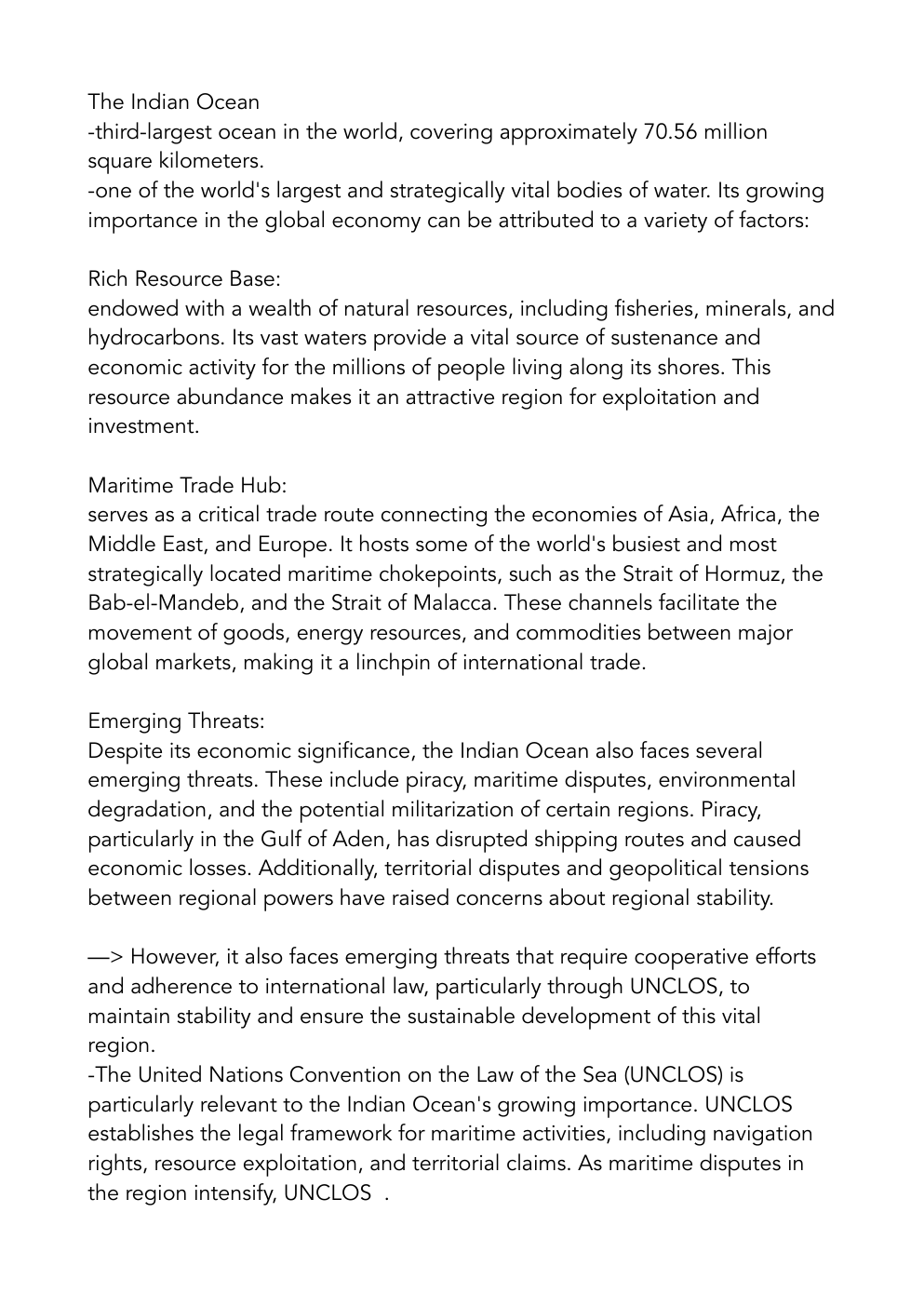The indian ocean
Publié le 25/11/2023
Extrait du document
«
The Indian Ocean
-third-largest ocean in the world, covering approximately 70.56 million
square kilometers.
-one of the world's largest and strategically vital bodies of water.
Its growing
importance in the global economy can be attributed to a variety of factors:
Rich Resource Base:
endowed with a wealth of natural resources, including fisheries, minerals, and
hydrocarbons.
Its vast waters provide a vital source of sustenance and
economic activity for the millions of people living along its shores.
This
resource abundance makes it an attractive region for exploitation and
investment.
Maritime Trade Hub:
serves as a critical trade route connecting the economies of Asia, Africa, the
Middle East, and Europe.
It hosts some of the world's busiest and most
strategically located maritime chokepoints, such as the Strait of Hormuz, the
Bab-el-Mandeb, and the Strait of Malacca.
These channels facilitate the
movement of goods, energy resources, and commodities between major
global markets, making it a linchpin of international trade.
Emerging Threats:
Despite its economic significance, the Indian Ocean also faces several
emerging threats.
These include piracy, maritime disputes, environmental
degradation, and the potential militarization of certain regions.
Piracy,
particularly in the Gulf of Aden, has disrupted shipping routes and caused
economic losses.
Additionally, territorial disputes and geopolitical tensions
between regional powers have raised concerns about regional stability.
—> However, it also faces emerging threats that require cooperative efforts
and adherence to international law, particularly through UNCLOS, to
maintain stability and ensure the sustainable development of this vital
region.
-The United Nations Convention on the Law of the Sea (UNCLOS) is
particularly relevant to the Indian Ocean's growing importance.
UNCLOS
establishes the legal framework for maritime activities, including navigation
rights, resource exploitation, and territorial claims.
As maritime disputes in
the region intensify, UNCLOS .
Indeed, today, the Indian Ocean region is witnessing a shift in its dynamics,
with a growing emphasis on intra-regional trade and a relative weakening of
trade with traditional major actors such as the United States, the European
Union, and Japan.
This shift can be explained by several key factors:
1.
Economic Growth in the Indian Ocean Rim Countries:
Many countries located along the Indian Ocean Rim, including
India, Indonesia, and South Africa, have experienced signi cant
economic growth in recent years.
This growth has led to an
increase in consumer demand within the region, driving intraregional trade.
For example, India's economic expansion has made
it a major consumer market, leading to increased....
»
↓↓↓ APERÇU DU DOCUMENT ↓↓↓
Liens utiles
- The indian Tragedy (résumé)
- Metis (Wisdom) Greek A Titan, daughter of Oceanus and Tethys, an Oceanid, or ocean Nymph, who was counted among the Titans.
- Doris (Bounty) Greek An Oceanid, or ocean Nymph; one of the eldest daughters of the Titans Oceanus and Tethys; herself considered a secondgeneration Titan.
- Indian Music I INTRODUCTION Classical Dance of South India The southern Indian kathakali is a dance drama that dates from the 17th century.
- Indian Art and Architecture I INTRODUCTION Art on the Indian Subcontinent This map highlights places in India and Pakistan where prominent examples of Indian art and architecture have been produced.

































